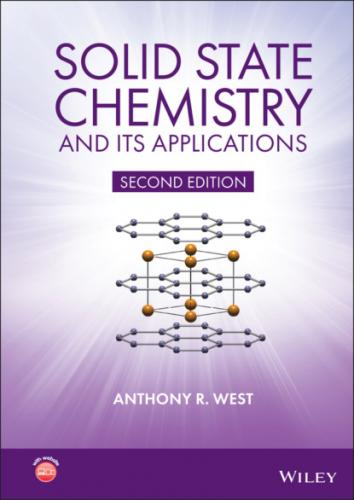Some compounds with the zinc blende structure are listed in Table 1.9. The bonding is less ionic than in compounds with the rock salt structure. Thus, oxides do not usually have the zinc blende structure (ZnO, not included in Table 1.9, is an exception; it is dimorphic with zinc blende and wurtzite structure polymorphs). Chalcogenides of the alkaline earth metals (but not Be) have the rock salt structure, whereas the chalcogenides of Be, Zn, Cd, and Hg have the zinc blende structure, as do Cu(I) halides and Γ ‐AgI. A range of III–V compounds (i.e. elements from Groups III and V of the Periodic Table) have the zinc blende structure and some, e.g. GaAs, are important semiconductors.
Table 1.8 Some compounds with the NaCl structure, a/Å
| MgO | 4.213 | MgS | 5.200 | LiF | 4.0270 | KF | 5.347 |
| CaO | 4.8105 | CaS | 5.6948 | LiCl | 5.1396 | KCl | 6.2931 |
| SrO | 5.160 | SrS | 6.020 | LiBr | 5.5013 | KBr | 6.5966 |
| BaO | 5.539 | BaS | 6.386 | LiI | 6.00 | KI | 7.0655 |
| TiO | 4.177 | α‐MnS | 5.224 | LiH | 4.083 | RbF | 5.6516 |
| MnO | 4.445 | MgSe | 5.462 | NaF | 4.64 | RbCl | 6.5810 |
| FeO | 4.307 | CaSe | 5.924 | NaCl | 5.6402 | RbBr | 6.889 |
| CoO | 4.260 | SrSe | 6.246 | NaBr | 5.9772 | RbI | 7.342 |
| NiO | 4.1769 | BaSe | 6.600 | NaI | 6.473 | AgF | 4.92 |
| CdO | 4.6953 | CaTe | 6.356 | TiN | 4.240 | AgCl | 5.549 |
| TiC | 4.3285 | LaN | 5.30 | UN | 4.890 | AgBr | 5.7745 |
Figure 1.33 The sphalerite (zinc blende) structure showing (a) the unit cell contents and (b) a more extended network of corner‐sharing tetrahedra.
1.17.1.3 Antifluorite/fluorite structure
The antifluorite structure has ccp/fcc anions with cations in all (T+ and T–) tetrahedral sites. The difference between antifluorite and fluorite is that antifluorite refers to an anion array with tetrahedral cations, whereas fluorite has the inverse arrangement with a ccp cation array and tetrahedral anions. Since the cation:anion ratio is 2:1 in antifluorite and the cation coordination is 4, the anion coordination must be 8, Fig. 1.30.
The very different coordination environments of anions and cations leads to two entirely distinct descriptions of the structure in terms of a 3D network of either tetrahedra or cubes, Fig. 1.34; (a) corresponds to the arrangement shown in Fig. 1.29(c) and the tetrahedra are highlighted; (b) corresponds to the arrangement in Fig. 1.30(b) in which the cubic coordination arrangement is highlighted. A more extended network of corner‐and edge‐sharing cubes is shown in Fig. 1.34(c). This must surely rate as one of the world's largest models of the antifluorite structure!
The antifluorite structure is shown by a large number of oxides and other chalcogenides of the alkali metals (Table 1.10), i.e. compounds of general formula
From Fig. 1.34(b) and (c), an alternative way of describing the fluorite structure is as a primitive cubic array of anions in which the eight‐coordinate sites at the cube body centres are alternately empty and occupied by a cation. It should be stressed that the true lattice type of fluorite is fcc and not primitive cubic, since the primitive cubes represent only a small part (one‐eighth) of the fcc unit cell. Description of fluorite as a primitive cubic array of anions with alternate cube body centres occupied by cations shows a similarity to the CsCl structure (see later). This also has a primitive cubic array of anions, but, instead, cations occupy all the body centre sites.
Table 1.9 Some compounds with the zinc blende (sphalerite) structure, a/Å
| CuF | 4.255 | BeS | 4.8624 | β‐CdS | 5.818 | BN | 3.616 | GaP | 5.448 |
| CuCl | 5.416 | BeSe | 5.07 |
